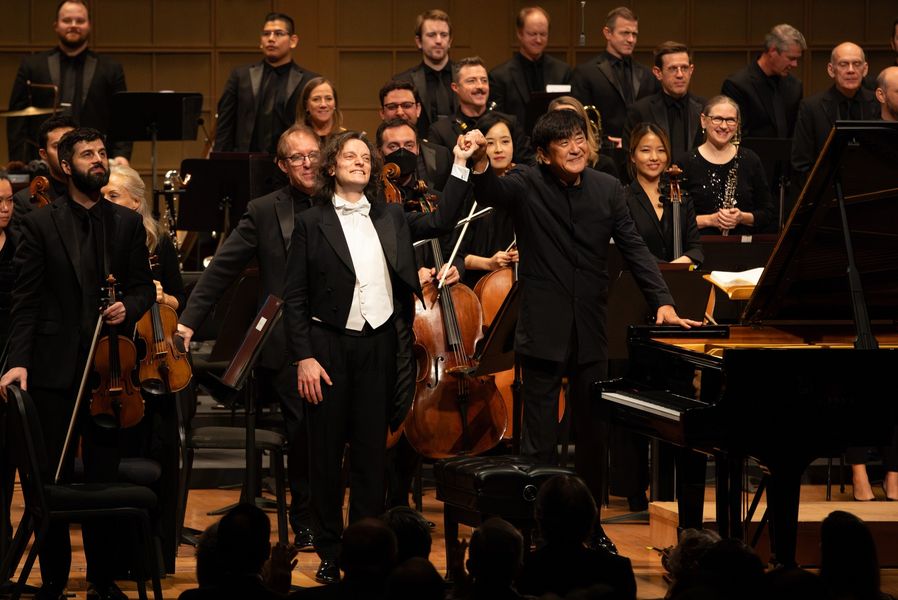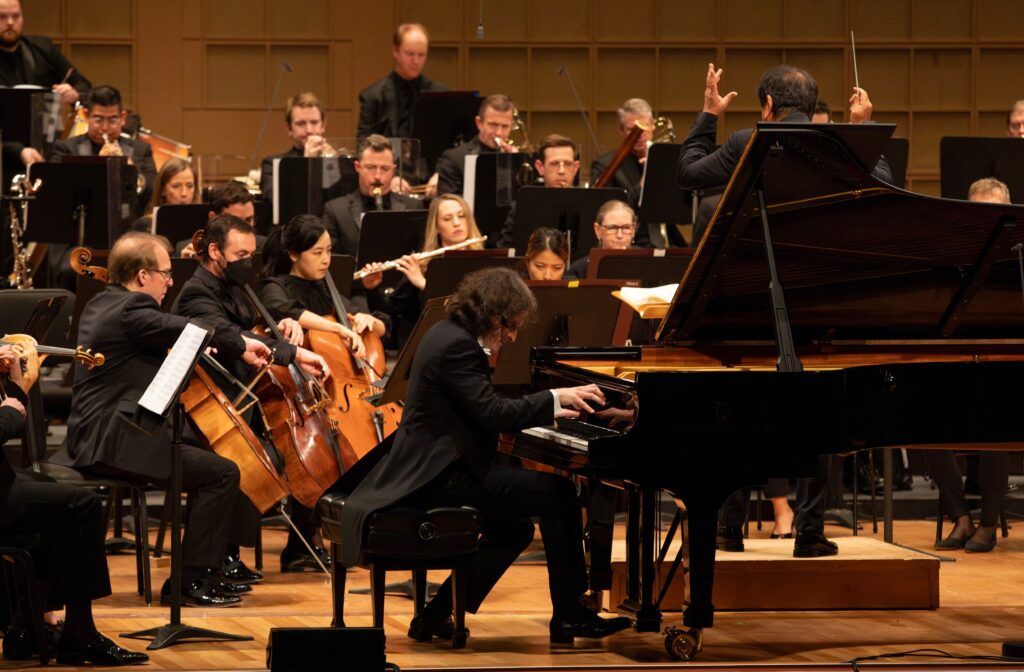Review: Yutaka Sado and the DSO brilliantly deliver a fresh program (Dallas Morning)

Guest conductor Yutaka Sado led orchestra playing brilliantly and elegantly. Pianist Alessandro Taverna performs with the Dallas Symphony Orchestra and guest conductor Yutaka Sado at the Meyerson Symphony Center on Nov. 16, 2023.

We’re getting a lot of great performances around here lately. On Thursday night, a fresh program from the Dallas Symphony Orchestra was played with passion and elegance under guest conductor Yutaka Sado. The Tchaikovsky Pathétique Symphony was gripping start to finish, and Sado and pianist Alessandro Taverna made a brilliant case for Benjamin Britten’s Piano Concerto.
Sado’s career seems to be more in Europe and his native Japan. A protégé Leonard Bernstein and Seiji Ozawa, he’s currently music director of the Austrian Tonkünstler Orchestra and the New Japan Philharmonic.
The program opened with another name new to me, Japanese composer Yasushi Akutagawa, who lived from 1925 to 1989. Trained in his native Tokyo, Akutagawa then spent time in Russia with composers Dmitri Shostakovich, Aram Khachaturian and Dmitri Kabalevsky, and he became well known in Japan for film and television scores.
Akutagawa’s Triptyque for string orchestra, from 1953, predates his Russian explorations. It sounds like a cross between Bartok and one of those 20th-century British composers — Gerald Finzi, say. The vigorous outer movements seem fancy transformations of folk dances, with reflective episodes. The central Berceuse is indeed a gentle lullaby.
Sado led a performance taut and spirited when needed, graciously shaped elsewhere. Co-concertmaster Nathan Olson dispatched a hoedown solo with panache.
The flashy beginning of the Britten Piano Concerto sounds for all the world like Prokofiev — which is no criticism. An accomplished pianist himself, Britten writes knowingly and imaginatively for the instrument, the first movement cadenza mingling grandeur, delicacy and turbulent cascades.
The second movement is a disoriented waltz, acquiring diabolic aggressions and surrealist glares. The ensuing “Impromptu” is actually a spooky passacaglia, the finale a tart march, with mischievous comments from winds.

Taverna didn’t advance beyond the preliminary round of the 2013 Van Cliburn International Piano Competition, but he’s gone on to a major career. His performance of the Britten displayed technical brilliance, wit and an amazing control of tone and dynamics.
Busy orchestral chatters in the first movement slipped out of perfect sync at one point, and winds’ tuning got a bit fuzzy in the finale, but otherwise Sado had the orchestra playing on high alert. Associated principal violist Matthew Sinno made fine work of the second movement’s opening solo. A rousing ovation was rewarded with a breathtakingly virtuosic Play Piano Play by Friedrich Gulda.
Sado’s Pathétique pas electrifying start to finish, but it was also fastidiously proportioned and warmly shaped – energy power – fully manipulated through time. With gestures from acrobatic to minimalist, Sado managed the rare trick of suggesting spontaneity within unrelenting tension.
Dynamics were exquisitely scaled, pianissimos as “charged” as great blasts of brasses. Ted Soluri’s bassoon solo set the solemn tone right at the start, and clarinetist Gregory Raden strung out some breathtaking pianissimos. The cellos’ final decrescendo into nothingness left the audience in stunned silence for what seemed forever.
Scott Cantrell
-
Recent News
- Review: Vacatello e Taverna, raffinatezza a quattro mani (Il Giornale di Vicenza) 1 March, 2024
- Review: Il Quartetto Indaco e Taverna, bella serata con Brahms (La Gazzetta di Parma) 21 February, 2024
- Video: Britten Piano Concerto – Dallas Symphony Orchestra (YouTube) 26 January, 2024
- Video: San Carlo, magia sinfonica (RAI TGR Campania) 1 January, 2024
- Review: Il rigore e la passione di Dego e Taverna (Il portale del violino) 18 December, 2023
- Review: Taverna, Ceretta e ORT (DeArtes) 11 December, 2023
- Review: Diego Ceretta con Alessandro Taverna e l’Orchestra della Toscana (Operaclick) 5 December, 2023
- Review: Angius, Taverna e l’OPV omaggiano Malipiero (Il Giornale della Musica) 24 November, 2023
- Review: Yutaka Sado and the DSO brilliantly deliver a fresh program (Dallas Morning) 18 November, 2023
- Review: Il Verdi di Trieste infiamma il pubblico (Musica) 11 October, 2023
- Review: Trieste, Teatro Verdi: Sesto concerto della stagione sinfonica (Operaclick) 9 October, 2023
- Interview: A Portogruaro la musica è multiverso (Il Giornale della Musica) 21 August, 2023
Latest tweets
Recent News
- Review: Vacatello e Taverna, raffinatezza a quattro mani (Il Giornale di Vicenza)
- Review: Il Quartetto Indaco e Taverna, bella serata con Brahms (La Gazzetta di Parma)
- Video: Britten Piano Concerto – Dallas Symphony Orchestra (YouTube)
- Video: San Carlo, magia sinfonica (RAI TGR Campania)
- Review: Il rigore e la passione di Dego e Taverna (Il portale del violino)
Next event
There are no upcoming events at this time.
